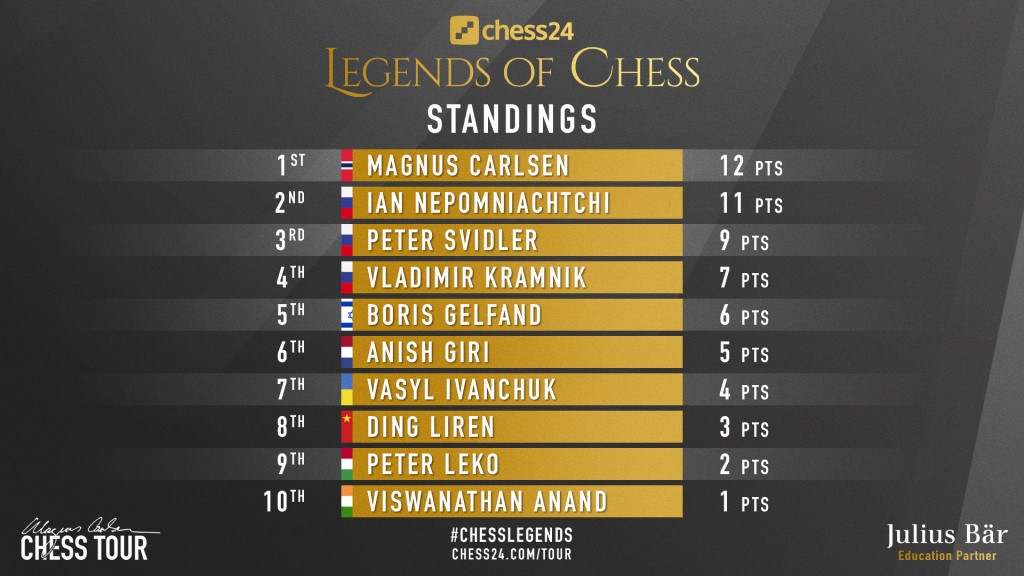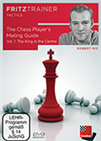Ding takes down Svidler
After three rounds, Peter Svidler was sharing the lead with world champion Magnus Carlsen, as both players had surmounted difficult situations to win their first three mini-matches without going to tiebreaks. On Friday, however, Svidler could not keep up with the Norwegian’s pace. While Carlsen scored a categorical 3:0 win over Boris Gelfand, Svidler was the first player in the event to lose against then tail-ender Ding Liren.
In the meantime, Svidler’s compatriots Ian Nepomniachtchi and Vladimir Kramnik climbed up in the standings table. Both Russians obtained 2½:1½ victories, over Vasyl Ivanchuk and Peter Leko respectively.
The one mini-match to go to Armageddon was Anish Giri versus Vishy Anand. The Dutchman played black and defeated the former world champion after the Indian found himself unable to deal with the almost inevitable time trouble in the blitz tiebreaker. Giri is now in sixth place, two points behind fourth-placed Kramnik.

Click to enlarge
Carlsen 3 : 0 Gelfand
This was the first time in the event someone scored a 3:0 victory. Known for starting slow in most tournaments, Carlsen came from beating Peter Leko with difficulty in round 3. However, his performance against Gelfand reminded us how much of a dominant player he can turn into when in good form. The world champion was his usual confident self when he told the Norwegian press:
I am not so concerned about whom I will be facing in the final. I will have a good chance to win anyway.
Carlsen faced the Sveshnikov Variation of the Sicilian in the first game, the same defence he had used with black in his World Championship match against Fabiano Caruana. As proven by what transpired in the game, he surely knows how to handle the position with the white pieces. Already two pawns up and with the initiative on his side, Carlsen decided to give up an exchange:
 Scarcely any world champion has managed to captivate chess lovers to the extent Carlsen has. The enormously talented Norwegian hasn't been systematically trained within the structures of a major chess-playing nation such as Russia, the Ukraine or China.
Scarcely any world champion has managed to captivate chess lovers to the extent Carlsen has. The enormously talented Norwegian hasn't been systematically trained within the structures of a major chess-playing nation such as Russia, the Ukraine or China.
Black’s previous 22...Bh3 was a mistake. Although 23.Rfc1 is best here, Carlsen’s 23.Bxg6 giving up the exchange is a more human — and also correct — way to move forward. 23...fxg6 24.Ne4 Bxc5 25.Qxc5 Bxf1 26.Rxf1 Qc8 27.Qxb5.
White has all the trumps in the position. Carlsen swiftly converted his advantage into a win.
Gelfand had a good position out of the opening in game 2, but a blunder on move 19 led to immediate resignation. The oldest player in the field could not recover from the pair of devastating games and also lost the third encounter. Currently in fifth place, the Israeli living legend is certainly within reach of qualifying to the semifinals.
Ding 2½ : 1½ Svidler
World number three Ding Liren has proven once and again that he is one of the very few players that realistically could put up a fight against Carlsen in a match, especially after his victory in the rapid tiebreaks of last year’s Sinquefield Cup — let us not forget that Carlsen won his last two matches for the world title in rapid playoffs.
Therefore, it was surprising to see the young Chinese in the cellar of the standings table, with no points to his name, after three rounds. In round 4, he also kicked off the day with a loss, but two wins with white gave him the mini-match victory he so much needed.
Svidler was trying to walk a tightrope in game 2 with his king the centre, and was duly punished by his rival when he faltered on move 24:
 One of the first lessons you learn in chess is to bring your king into safety by castling – be it on the kingside or the queenside - after having developed your minor pieces. By ignoring this rule of thumb, not only may your king end up in trouble, but your other pieces and in particular, your rooks, may never end up playing much of a role, and before you know it, things are looking grim. Even at the highest level, the consequences of neglecting this basic element of opening theory has been frequently underestimated. In this first volume of the new Mating Guide series, the emphasis will be on how to exploit a vulnerably placed king in the centre. A must-have for ambitious chess players who want to improve their own attacking skills.
One of the first lessons you learn in chess is to bring your king into safety by castling – be it on the kingside or the queenside - after having developed your minor pieces. By ignoring this rule of thumb, not only may your king end up in trouble, but your other pieces and in particular, your rooks, may never end up playing much of a role, and before you know it, things are looking grim. Even at the highest level, the consequences of neglecting this basic element of opening theory has been frequently underestimated. In this first volume of the new Mating Guide series, the emphasis will be on how to exploit a vulnerably placed king in the centre. A must-have for ambitious chess players who want to improve their own attacking skills.
Ding did not hesitate to open up the position with 25.f5 gxf5 26.Bg5+ Ke8 27.Bxd8 fxe4 28.Bf6 Rg8 29.Rd1 and Black resigned.
Svidler tried a different line of the Slav Defence in game 4, but was once again overrun by Ding’s energetic play:
White is clearly better developed, so it is time to take action. 19.Bh6 Nh5 [19...gxh6 20.Nxf6 with a discovered attack on the queen] 20.Qf3 Bg5 The decisive mistake [20...gxh6 21.Qxh5 Bg5 22.Qf3 and Black is worse but can keep fighting] 21.Nf4 Qf6 22.Bxg5 Qxe5 23.Qxh5 h6 24.h4 Kg8 25.Re1 Qf5 26.g4
Here Black resigned. The forced variation favoured the player with the better developed position — in this case, Ding Liren.
Kramnik 2½ : 1½ Leko
The contenders for the 2004 World Championship title played an exciting match. Most notably, game 3 was a total rollercoaster. Kramnik had the white pieces:
Leko had the initiative until his previous move, which gave way to 34.e4 Qf4 35.Nd4 Qg6 36.Nxe6 Qh4
 This DVD allows you to learn from the example of one of the best players in the history of chess and from the explanations of the authors (Pelletier, Marin, Müller and Reeh) how to successfully organise your games strategically, consequently how to keep y
This DVD allows you to learn from the example of one of the best players in the history of chess and from the explanations of the authors (Pelletier, Marin, Müller and Reeh) how to successfully organise your games strategically, consequently how to keep y
It was time for Kramnik to grab material with the natural 37.Nxc5, and Black does not have near to enough compensation. Instead, the former world champion went for 37.Qd4, gravely complicating his task.
About ten moves later, it was Leko who was in the driver’s seat, although all he could get in the end was a rook and knight v rook endgame. The Hungarian tried to convert the theoretically drawn position until move 119, but to no avail — Kramnik knew how to hold the draw.
Leko’s inability to make the most of his chances led him to a second mini-match loss in a row, and both times he was defeated in the fourth rapid game.
Nepomniachtchi 2½ : 1½ Ivanchuk
Much like Kramnik, Nepomniachtchi drew the first three games and obtained a deciding win in game 4. Ivanchuk was playing white, but was in trouble right out of the opening. ‘Nepo’ handled his advantage proficiently and got to checkmate his opponent in the end:
40.Re2 allowed mate — 40...Rf1+ 41.Ka2 Ra1# 0-1.
Giri 3 : 2 Anand
Things are not going well for Anand in this tournament, as he is now in last place after having collected only one point thus far. In fact, he got the point in round 4, when his matchup against Giri went to Armageddon after the four rapid games finished drawn.
In the sudden-death encounter, Anand had the upper hand with the white pieces:
 The most popular chess program offers you everything you will need as a dedicated chess enthusiast, with innovative training methods for amateurs and professionals alike.
The most popular chess program offers you everything you will need as a dedicated chess enthusiast, with innovative training methods for amateurs and professionals alike.
From a visibly inferior position, Giri muddied the waters with 39...Nxg4. Anand took the bait by capturing the piece with 40.fxg4, when keeping things under control with 40.a5 was the correct alternative. Giri continued to play quickly and saw his opponent falter in time trouble.
Links
























